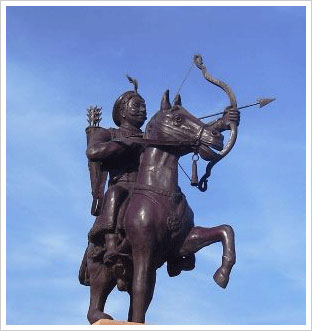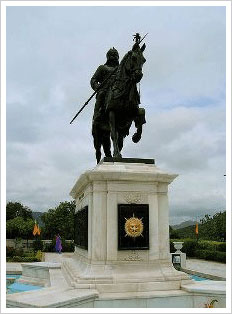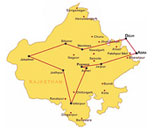History of Rajasthan
According to the Hindu Mythology, the Rajputs of Rajasthan were the descendants of the Kshatriyas or warriors of Vedic India. The emergence of the Rajput warrior clans was in the 6th and 7th centuries. Rajputs ancestry can be divided into two: the "solar" or suryavanshi-those descended from Rama, the hero of the epic Ramayana, and the "lunar" or chandravanshi, who claimed descent from Krishana, the hero of the epic Mahabharata. Later a third clan was added, the agnikula or fire-born, said to have emerged from the flames of a sacrificial fire on Mt Abu.
It has been accepted that the Rajputs were divided into thirty-six races and twenty-one kingdoms. The Rajput clans gave rise to dynasties like Sisodias of Mewar (Udaipur), the Kachwahas of Amber (Jaipur), the Rathors of Marwar (Jodhpur & Bikaner), the Hadas of Jhalwawar, Kota & Bundi, the Bhattis of Jaisalmer, the Shekhawats of Shekhawati and the Chauhans of Ajmer.
Some popular rulers have been listed and given below according to period:
Ancient Period, upto 1200 Century
Rajput clans emerged and held their sway over different parts of Rajasthan from about 700 AD. Before that, Rajasthan was a part of several republics. It was a part of the Mauryan Empire. Other major republics that dominated this region include the Malavas, Arjunyas, Yaudhyas, Kushans, Saka Satraps, Guptas and Hunas.
The Rajput clans ascendancy in Indian history was during the period from the eighthto the twelfth century AD. The Pratihars ruled Rajasthan and most of northern India during 750-1000 AD. Between 1000-1200 AD, Rajasthan witnessed the struggle for supremacy between Chalukyas, Parmars and Chauhans.
Bappa Rawal (713 - 753)
Prithvi Raj Chauhan (1168 - 1192)

Medieval Period, 1201 - 1750 Century
Rana Kumbha (1419 - 1469)
Maharana Pratap (1540 - 1597)

Pratap, eldest of 25 brothers and 20 sisters, was born at Kumbhalgarh to Maharana Udai Singh II and Maharani Javanta Bai Songara (Chauhan). Maharana Pratap was born in Pali-Marwar. His birthplace is known as Juni Kacheri.
Maharana Udai Singh (1542 - 1572)
Mirza Raja Jai Singh (1611 - 1667)
At the tender age of 10 Jai Singh I became the Raja of Amber and the head of the Kachwaha Rajputs. His military career spans the full reign of Shah Jahan and the first half of Aurangzeb's reign. Jai Singh's first step in his rise to greatness took place on the accession of Shah taking advantage of this change of sovereigns.
Rao Bika
Rao Bika left Marwar (Jodhpur) to create his own kingdom. Rao Jodha supported Bika in his endeavours in return in return for which he made Bika promise never to try and take the throne of Mewar.Some valuable family heirlooms which would legitimize his right to found a kingdom were promised to Bika.
Maharaja Sawai Jai Singh (1688-1743)
Due to the policy of appeasement, the matrimonial alliances and the solid military support offered by Amber-Jaipur to the Moghuls, this state escaped the sacking and constant warfare which disrupted other Rajput principalities. As a result, the state of Jaipur was the most advanced at the time of Indian independence (1947)
Jaipur as a matter of course became the capital of the newly formed state of Rajasthan. Its ruler, Sawai Man Singh II became Rajpramukh of Rajasthan. His wife, now RajmataGayatri Devi entered politics and is a member of parliament. Sawai Man Singh was a great polo player. His son and heir Bhavani Singh is an officer in the Indian Army and won the Mahavira Chakra for conspicuous bravery in the 1971 war with Pakistan thus maintaining the martial traditions of the Rajputs.

